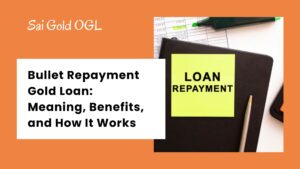Gold has always held a special place in India’s economy and culture not just as jewelry but as a valuable financial asset. With the increasing popularity of gold loans, understanding how gold prices impact your loan eligibility is crucial. Gold loans are secured loans offered by banks and non banking financial companies (NBFCs) against the value of your gold ornaments or coins.
In essence, the value of gold you pledge determines how much money you can borrow. However, since gold prices fluctuate daily due to market conditions, your loan amount, eligibility, and even interest rates may change accordingly.
This article explores the link between gold valuation, market fluctuations, and loan limits so you can make informed borrowing decisions.
1. Gold Valuation: The Foundation of Loan Eligibility
Before granting a gold loan, lenders must assess the market value of your gold. This process is known as gold valuation. The higher the gold’s market value, the higher your potential loan amount.
a. How Gold Valuation Works
Lenders typically:
- Assess the purity of your gold (measured in karats, e.g., 22K or 24K).
- Determine the current market price per gram of gold.
- Multiply the purity and weight to calculate the total value.
- Apply a Loan to Value (LTV) ratio, which determines the maximum percentage of that value they can lend.
For example, if you pledge 100 grams of 22K gold, and the market price is ₹6,000 per gram, the total value is ₹6,00,000. If the lender applies an LTV of 75%, you can get a maximum loan of ₹4,50,000.
b. Role of the LTV Ratio
As per RBI (Reserve Bank of India) regulations, lenders can offer up to 75% of the gold’s market value as a loan. This limit ensures protection against market volatility. So even if gold prices drop after the loan is disbursed, the lender’s risk is minimized.
2. Market Fluctuations and Their Impact on Gold Loans
The global gold market is influenced by several factors like:
- Inflation and interest rates
- Currency fluctuations (especially USD,INR rates)
- Geopolitical instability
- Demand during festivals or wedding seasons
These factors cause daily changes in gold prices, which directly affect your loan eligibility.
a. When Gold Prices Rise
When gold prices increase:
- The value of your pledged gold rises.
- You may become eligible for a higher loan amount for the same gold weight.
- Your loan-to-value ratio remains constant, but the overall loan quantum increases.
For example, if the gold price rises from ₹6,000 to ₹6,500 per gram, the same 100 grams of gold is now worth ₹6,50,000. With a 75% LTV, your eligible loan amount jumps from ₹4,50,000 to ₹4,87,500.
b. When Gold Prices Fall
Conversely, when gold prices drop:
- The assessed value of your pledged gold decreases.
- Your loan eligibility reduces accordingly.
- If you already have a gold loan, you may be asked to repay part of the loan or add more gold collateral to maintain the LTV ratio.
A sudden decline in gold rates can therefore pose a risk, especially for borrowers with long-tenure gold loans.
3. Loan Limits and Eligibility Criteria
While gold valuation and price fluctuations play a significant role, lenders also apply other eligibility parameters to determine how much you can borrow.
a. Factors Influencing Gold Loan Limits
- Gold Purity and Weight:
Only gold between 18K and 24K is accepted, with higher purity fetching higher valuations. - Market Price:
Determined daily using standard rates issued by local gold associations. - LTV Ratio:
Capped at 75% by the RBI, though some lenders may offer less to reduce risk. - Borrower’s Profile:
Although gold loans don’t require credit checks, some lenders still consider your repayment history or existing liabilities before final approval. - Type of Gold Accepted:
Only hallmarked jewelry or coins (usually up to 50 grams per RBI guidelines) are eligible.
b. Loan Tenure and Repayment
Gold loans usually range between 3 months to 3 years, with flexible repayment options such as:
- Bullet repayment: Pay full interest and principal at the end of tenure.
- EMI-based repayment: Fixed monthly payments of principal and interest.
- Interest-only option: Pay interest monthly and principal later.
Longer tenures can expose you to more price fluctuation risk, so shorter tenures are often safer.
4. How to Maximize Your Gold Loan Eligibility
- Pledge Higher Purity Gold: 22K or 24K gold fetches better valuations.
- Monitor Market Prices: Apply for a gold loan when gold rates are high.
- Choose a Reputed Lender: NBFCs and banks may offer different appraisal methods — compare before applying.
- Avoid Over-Borrowing: Leave a margin in case gold prices fall.
- Repay on Time: Timely repayment can improve your creditworthiness for future loans.
5. The Relationship Between Gold Prices, Interest Rates, and Risk
While gold price determines the loan amount, it can also influence interest rates indirectly.
- When gold prices are high and stable, lenders feel more secure, which can lead to competitive interest rates.
- When gold prices are volatile, lenders may increase interest rates to offset risk.
Thus, monitoring gold market trends can help you choose the best time to apply for a gold loan.
Frequently Asked Questions (FAQs)
Lenders calculate the loan amount based on the current market value of your gold and apply a Loan-to-Value (LTV) ratio,usually up to 75%.
Yes. If gold prices fall significantly, lenders may ask you to deposit additional collateral or repay part of the loan to maintain the LTV ratio.
If you default on repayment, the lender has the right to auction your pledged gold to recover the outstanding dues.
Not necessarily. Gold loans are secured loans, so lenders are more focused on the gold’s value than your credit score.
Yes. Higher gold prices increase your gold’s value, thus improving your loan eligibility and maximizing the sanctioned amount







